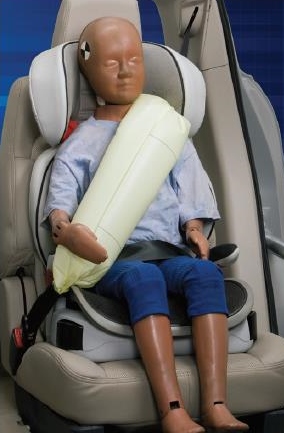As of March 2011, the touted inflatable seat belt becomes available as a $195 option for rear-seat positions in the 2011 Ford Explorer. Ford has expressed much enthusiasm for this technology, which has been in development for many years. It represents one of few safety improvements in the vehicle industry that is targeted specifically to protect rear seat occupants. Though currently available only in North America, and only on XT and Limited versions of the 2011 Explorer model, the outcome of this initial introduction may lead to more widespread availability in the future.
For now, CPSTs should be aware that this new type of belt exists and anticipate that adjustments to advice may be needed when educating families who own Explorers with this feature. As always, be sure to refer to the owner’s manuals for the vehicle and the CR to check for special instructions.
 Ford and CR Manufacturer’s Instructions May Differ
Ford and CR Manufacturer’s Instructions May Differ
Ford has taken many measures to reassure the public that its inflatable seat belts are compatible with CRs of all types. Srini Sundararajan, a Ford engineer who worked on the system, explained to Safe Ride News that, though the inflated belt will cover five times the area of a regular seat belt, it does not deploy with the same force as air bags in the front seat of vehicles due to the fact that it is already positioned across the occupant’s chest. Ford has taken many media opportunities to describe the extensive testing that it has conducted with a variety of CR types, models, and belt routings, including bases with lock-offs and boosters with shoulder-belt guides.
CR manufacturers may have a different viewpoint regarding whether (and how) these belts may be used to install their products. As reported in the last SRN, Britax has already altered instructions to prohibit the use of these belts for installation of Britax CRs, including boosters. Ford representatives have recently indicated to SRN that Ford is meeting with CR manufacturers, including Britax, in order to provide information and any further testing needed to alleviate concerns, and they remain hopeful that Britax will lift its prohibition (and that others will not add such restrictions). At press time, however, Sarah Tilton of Britax reports that Britax has not retracted these instructions.
The Vehicle Setting
In addition to this new seat belt technology, the Ford Explorer has been completely redesigned for 2011 to have a unibody construction (versus its previous truck-based chassis), which means that now it will be available only in a 3-row version. Vehicles with the optional inflatable rear seat belts will be so equipped only in the two outboard positions of the center row of the vehicle. Therefore, only regular seat belts will be available in the center position of the second row (in bench seat versions) and in the two third-row positions, all of which can be used for CR installation.
Installation using LATCH rather than a seat belt is another viable strategy to bypass potential limitations imposed by the inflatable belts. Full LATCH systems are available in both outboard vehicle seats where the optional inflatable seat belts may be installed, and a third system is found in the third-row, passenger-side position.
The existence of these many alternatives to using the center-row outboard seat belts suggests that it may often be possible to avoid installing CRs with inflatable belts.
Using an Inflatable Belt for Installation
When it is both necessary/preferred and allowed to install with inflatable belts, be sure to check the vehicle instructions, since these systems are different than the styles that are commonly found in most vehicles over the past several years. In particular, there are separate retractors at the anchor points for the shoulder and lap belts, and the latchplate is sewn on to the webbing that spools out from each of these retractors. The webbing for the lap belt is the typical kind, but the shoulder belt webbing, which has the inflatable component, feels somewhat softer than usual webbing and is about twice as thick. For CR installation, the retractor for the lap belt will be lockable by employing the typical technique of pulling the webbing fully out of the retractor to switch to locked mode.
To further complicate CR installation, a careful reading of many CR manuals reveals that dual-retractor systems like this are specified as not allowed for installation, regardless of whether an inflatable belt is present or not. This may be because many of the now-older vehicles that were equipped with dual seat belt systems in past years did not include a lockability feature in the lap belt. Therefore, many CR instruction, as currently written, will not allow the use of Ford’s inflatable belts due to the dual-retractor aspect of its design, despite the fact that there is a lockable retractor in the lap belt. SRN has alerted Ford to this problem, as efforts on that company’s part to convince CR manufacturers to be unconcerned with the inflatable feature of the seat belt will be for naught if the dual-retractor aspect is also prohibited from use for installation in the CR user’s manuals.
Another consideration will be using the lock-offs of some CRs. Despite the fact that Ford reports that its extensive testing has included many types of lock-off designs and that these tests have shown no problems, we feel the thickness of the shoulder belt may make it difficult to use many lock-offs. Whenever allowed by the CR instructions, it may be easier to bypass the lock-offs altogether and rely instead on locking the lap belt to hold the belt at a fixed length.
SRN will continue to follow this story and will report on changes as they develop.

